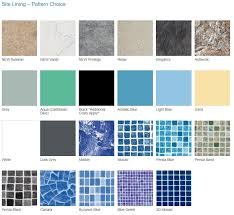When designing or maintaining a swimming pool, one crucial element that should not be overlooked is the pool line. The pool line not only defines the structure and aesthetics of your pool but also plays a vital role in ensuring its functionality and longevity. From vinyl to tile, various materials are available for pool lines, each offering distinct advantages. In this blog, we will explore the different types of swimming pool lines, helping you make an informed decision on the right one for your pool.
What is a Swimming Pool Line?
A swimming pool line refers to the edging or border that outlines the edge of a pool. It can be both functional and decorative, serving the dual purpose of adding visual appeal and providing a physical boundary between the pool and its surrounding area. Swimming pool lines are not just about looks—they also play a significant role in water circulation, cleaning efficiency, and safety. Various materials can be used to create pool lines, each offering unique features that suit different pool designs and maintenance preferences.
Vinyl Swimming Pool Lines
Vinyl pool lines are a popular choice for homeowners seeking an affordable and flexible option for their swimming pool borders. Vinyl is a synthetic material that can be easily customized to fit various pool shapes and sizes. It is typically used as part of the pool’s liner system, where the entire pool is lined with vinyl for both aesthetic and practical purposes.

Advantages of Vinyl Pool Lines:
- Cost-Effective: Vinyl pool lines are generally less expensive than other materials, making them a budget-friendly option for pool owners.
- Customizable Designs: Vinyl offers a range of design options, including different colors, patterns, and textures that can match various pool themes.
- Smooth Surface: The material is smooth to the touch, preventing abrasions or discomfort for swimmers.
- Easy Maintenance: Vinyl is easy to clean and maintain, requiring minimal effort to keep it looking great throughout the year.
Despite these benefits, vinyl may not be as durable as some other materials, and over time, it can be prone to fading, tearing, or stretching, especially under harsh weather conditions.
Tile Swimming Pool Lines
Tile is a classic material often used for the pool line, especially in high-end pools or when aiming for a more luxurious appearance. Tiles are typically made of ceramic, porcelain, or glass, and they can be arranged in various patterns to create a customized look for the pool’s edge.
Advantages of Tile Pool Lines:
- Durability: Tile is known for its strength and longevity. A tile pool line can withstand extreme temperatures and the wear and tear of daily pool use.
- Aesthetic Appeal: Tiles are available in a wide variety of colors, textures, and designs, offering unmatched versatility. You can opt for bold colors, intricate mosaics, or minimalist designs to create the perfect look for your pool.
- Low Maintenance: Tile pool lines are easy to clean and resistant to mold or algae buildup, as the grout between tiles can be sealed to prevent water penetration.
- Non-Slip Surface: Ceramic and porcelain tiles are generally slip-resistant, making them a safe option for pool areas.
While tile pool lines are durable, they can be expensive, especially for high-quality materials. Additionally, the grout between tiles may require occasional maintenance to keep it clean and intact.
Concrete Swimming Pool Lines
Concrete pool lines are another popular option, particularly for custom-built pools. Concrete offers the flexibility to create unique shapes, patterns, and textures, and it is known for its strength and durability.
Advantages of Concrete Pool Lines:
- Customization: Concrete can be shaped into virtually any design, making it an excellent option for pools with non-standard shapes or unique features.
- Longevity: Concrete is incredibly durable and resistant to damage from pool chemicals, water pressure, and extreme weather conditions.
- Variety of Finishes: Concrete pool lines can be finished in various ways, including smooth, textured, or with decorative coatings such as pebbles, tiles, or mosaic patterns.
- Low Maintenance: Once the concrete pool line is sealed and finished, it requires minimal maintenance, only needing occasional cleaning.
However, concrete pool lines can be expensive due to the labor and materials involved in installation. Moreover, the surface may be rougher than other options, which could make it uncomfortable for swimmers.
Stone Swimming Pool Lines
Stone pool lines, made from natural stones like granite, limestone, or slate, offer a rustic and elegant aesthetic. These materials are often chosen for their durability, natural beauty, and timeless appeal.
Advantages of Stone Pool Lines:
- Natural Aesthetic: Stone provides a classic, earthy look that blends beautifully with outdoor landscapes.
- Durability: Stone pool lines are highly resistant to weather conditions, pool chemicals, and physical damage, ensuring longevity.
- Non-Slip: Natural stone is often slip-resistant, which is essential for ensuring the safety of swimmers.
- Low Maintenance: Stone pool lines are relatively easy to clean and maintain, requiring occasional sweeping and sealing.
The downside to using stone is that it can be quite costly, both in terms of the material and installation. Additionally, stone can become slippery when wet if not properly sealed or textured.
Plastic Pool Lines
Plastic pool lines, made from various synthetic materials, are a more affordable alternative to stone, tile, or concrete. They are often used in above-ground pools or as a part of an overall cost-effective pool design.
Advantages of Plastic Pool Lines:
- Affordability: Plastic pool lines are typically much less expensive than alternatives like tile or stone.
- Easy to Install: Plastic is lightweight, making it easier and faster to install compared to heavier materials.
- Low Maintenance: Plastic pool lines require minimal maintenance and are easy to clean.
While plastic pool lines are affordable and functional, they may not have the same aesthetic appeal or durability as other materials. They are also more prone to cracking or fading over time.
Conclusion
Choosing the right swimming pool line is an important decision that depends on your budget, aesthetic preferences, and the level of maintenance you’re willing to undertake. Whether you opt for vinyl for its affordability and customization options, tile for its timeless elegance, or concrete and stone for their durability, each type of pool line offers unique benefits. It’s essential to evaluate your pool’s design, functionality, and how much care you’re willing to invest when making your decision.
Ultimately, the right swimming pool line can enhance your pool’s visual appeal, contribute to its longevity, and improve the overall swimming experience. Whether you choose a simple vinyl edge or a luxurious stone border, your swimming pool line will make a lasting impression on both your pool and your guests.









Leave a reply